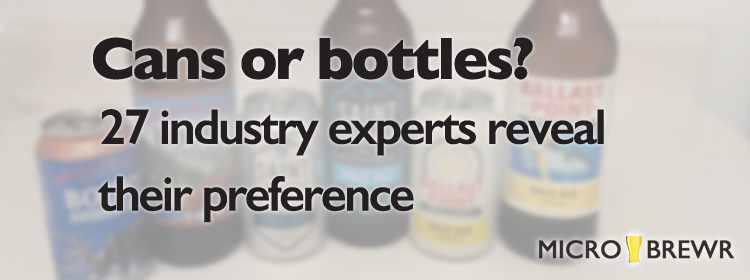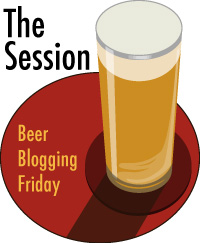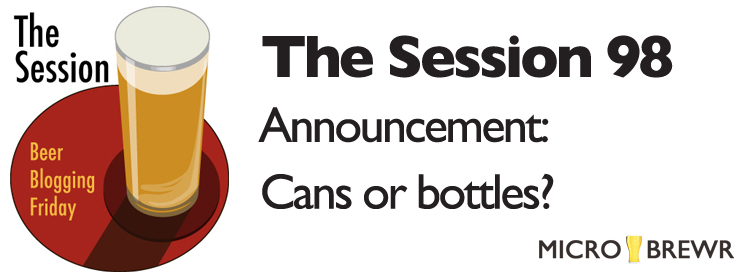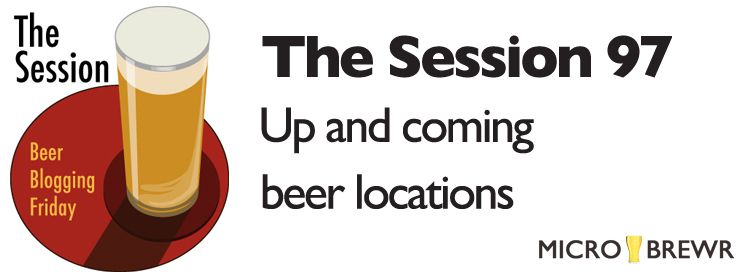The Session 98 roundup: Cans or bottles?
Thank you everyone who contributed to my self-serving blog topic: Cans or bottles? MicroBrewr is all about starting a brewery. One important question is how to package the product.
The price tag is pretty hefty for a commercial line for cans or bottles. Either one could cost hundreds of thousands, or even millions, of dollars. So the question is important to anyone planning to start a brewery. Luckily, recent developments in mobile canning lines and mobile bottling lines have significantly reduced the price and the barrier of entry.
But the dilemma doesn’t stop at the bottom line.
It’s not just about what the customers want, cans or bottles. Clearly trends are shifting. Many people still holdout for bottles. Meanwhile cans, which once carried a stigma, are increasingly accepted and sometimes even sought.
It’s not just about the brewer’s preference for cans or bottles. Some purport that bottles protect the beer better, while many claim the same for cans. Of course brewers and brewery owners are not immune to the same personal preferences that sway decisions for customers. So their claims of logic in the decision are likely blemished by bias also.
To try and figure it out, since undertaking MicroBrewr last June, I’ve asked every guest of the podcast this same, simple question: Cans or bottles?
Some people think the debate is dead, but clearly people are still talking about it. It’s still worth discussing. Some of the guests find the question difficult to answer and some find it quite a dilemma.
Check out a more in-depth study of their answers in my contribution to The Session 98:
Cans or Bottles? 27 industry experts reveal their preference.
And here’s the page with ongoing tabulations.
Sign up for the email list: Sign me up!
Here are the other contributions:
David Preston at Beer Tinted Spectacles writes a bunch about milliliters. Evidently the bloke is a Britton. I had to keep Googling conversions. He calls a 12-oz. can a small can, and says that’s the common size in the U.K. for soda, but not so much for beer, in which they have a much wider variety of serving sizes. In the U.K., beer in cans can be bought in 14-oz., 16-oz., or 19-oz. varieties. Be careful when you order a pint in Great Britain, you’ll probably get a 19-oz. “Imperial Pint” rather than the 16-oz. size you’re used to in the U.S.
His piece isn’t just about serving size. I really like that Preston dives into the whole notion of perception. “We say rational. We do irrational,” he admits. And it’s not up to us. The views of “opinion formers”—brewery owners—“are now impacting drinkers behaviour and perceptions.” But who cares he asks, “If beer drinkers become accepting of both, then that’s good for beer isn’t it?” Tune in for the plot twist that he sends us on in the last graph.
The Beer Nut writes from Ireland, next door to—but not part of—the U.K., which would be Northern Ireland. To commemorate The Session, he drinks and writes about 4 British beers, one of them is from a can. Mostly his piece just makes me thirsty. He does provide a link to another blog that argues against the ability of lower priced canning lines to seal out air. Alas, he writes, “For the moment I’m not fussed what a brewery puts its beer in, as long as what comes out is [high quality].”
Another Dubliner, Reuben Gray at The Tale Of The Ale, writes of one canned beer: “I’m not going to talk about the beer inside the can because it tastes the same as the draught version.” Then he presents pros and cons for cans and for bottles. In his presentation cans do seem best. Yet he does remind us in an asterisk that the plastic liner inside cans is made of plastic, which contains chemicals, a point that I keep having trouble getting past.
Jeremy Short at Pintwell writes specifically about a taste test of “a classic”: Pilsner Urquell. This beer lost a recent taste test among his friends, but he loves it. He has his wife pour the canned version and the bottled version so he can do a blind side-by-side comparison. Perhaps not a scientific study, “I had 50/50 odds anyway,” he admits. He doesn’t need such odds in his favor. “It was mind blowing to me how different the two beers were.”
You’ll have to read his post to find out which he prefers. Though I’d take it with a word of caution. I’ve done 2 separate cans versus bottles blind taste tests with friends. It was usually pretty easy to discern a difference in appearance, aroma, and flavor, but sometimes is was the canned beer that we preferred, and sometimes it was the bottled beer.
Related: Cans or Bottles? Surprising results from two blind taste tests
Derrick Peterman writes at Ramblings of a Beer Runner. “Plenty of beers come and go,” he writes, “but we’ve just got one planet. So the question for me boils down to whether bottles or cans are better for the environment?” Great point. I used to make my entire voting decisions based on this one notion. But I don’t mean to turn this into a political discussion. He writes of pollution during transportation, chemicals and energy use during manufacturing, percent recycled content. And finally he concedes, “No one really knows,” and he cites sources for this.
“Reduce, Reuse, Recycle,” is the phrase. And they’re listed in order of importance. Kegs and growlers are meant for reusing. And Peterman offers a neat, recycled (if I may) solution for single-use containers, too.
Alan McLeod from the Beer Blog has an interesting contribution, albeit a recycled one (there I did it again). He repurposes a post from 2006 that includes emails with the “Lead Singer” of Oskar Blues Brewery. Of course Oskar Blues is something of a pioneer for craft beer in cans. We have them to thank for their foresight and risk-taking, at the time anyway. As it turns out, the whole thing was some sort of a sick joke. Check out the piece for the full story and the definitive history of how we came to enjoy great craft beer in cans everywhere.
Craig, or someone else, at Oregon Beer Life kind of writes off the topic. I mean he wrote it off. I mean he wrote… Gosh it’s getting late. Well, he said that he has already written so much about this topic, that it seems like he has nothing more to write. Instead he just links to some other posts, mostly cans versus bottles taste tests.
Then a discussion at a book signing urged him to write more. He points out that mobile canning lines and mobile bottling lines make it cheaper than ever for startup breweries to put their beer and their dreams into packaging for distribution. “It’s increasingly less important these days,” he says, “for startup breweries to have to consider can or bottle packaging equipment if this option is available to them.” It’s a great point. I agree with him that, “to a certain extent I don’t think this question is as necessary when considering starting a brewery as it once was.” What great times in which we live…
Dan “the web nerd” of Community Beer Works ponders that they will one day have to make this decision for their brewery. In the meantime, fearing nothing new to contribute to the discussion, he does a taste test. His is not blind, he apparently poured the beer for himself. Although, I appreciate his efforts to keep it as “scientific” as possible. (His quotation marks, not mine.) Like Short at Pintwell, Dan notices a significant difference between the two.
“I can only say that because I’m sitting here doing my damndest to compare the two,” he admits. “If I had the bottle today and the can next week I probably wouldn’t notice much difference.”
After that, he throws us for loop. Then he admits, it’s all about laziness.
Liam at Drunken Speculation seems… I’m not sure what he seems. I’m not sure what to make of his feelings on the topic, although this is purportedly his first contribution to The Session in 6 months. So that helps alleviate some of my worries shared by some previous hosts about my topic being unworthy. He says bottles are preferred by Che Guevara, Richard Nixon, Joseph Stalin, and somehow genocide. “So I suppose you can have your bottles if you hate freedom,” he writes.
It seems Liam prefers cans. My favorite of his arguments against bottled beer is: “Get off your high horse you elitist prick.” And that cans will save the polar bear. It’s definitely entertaining, which I think might be the point.
Sean Inman at Beer Search Party is our “Lewis and Clark” of finding great beer. Not sure he’s the right guide for this party as he has “swung from bottles to cans and back and forth like a pendulum.” But he does attempt to sate my desire for “empirical evidence” about the question at hand. He does so with a list, 4 points a brewery should ponder when considering which package to use. He seems to present this lightly and with humor. Yet he offers good points for all brewery marketing, not just the choice in packaging.
Finally, Stan Hieronymus from Appellation Beer and one of the 2 co-hosts of The Session, is most concerned with beer aroma. “I’m not inclined to want to stick my nose up to that half-inch wide opening in the can,” he cautions.
My sister once licked the lid of a can of bean dip and cut her tongue deeply. I thought I would cut my finger deeply when I once got it stuck in the opening of a soda can. (It turned out okay in the end.)
Like McLeod from Beer Blog, Hieronymus quotes an email from Oskar Blues, who says beer should be poured from the can into a drinking glass. Yet, people are drinking from cans, Hieronymus says. He pours his into a glass. Me too.
Related: The Session 97: Up and coming beer locations
Conclusion
So those are some thoughts on the debate. Those are some ideas to ponder when trying to decide how to package your beer.
There are many factors to consider. And some people are still pretty adamant for either cans or bottles. Luckily, these days great beer is put into both types of packaging, and both types are doing very well in the marketplace.
Stay tuned for The Session 99 hosted by Fuggled, who has chosen the topic: Mile Ale. Keep an eye out for their announcement coming soon, or check back at The Sessions HQ.
Thanks everybody for contributing. Sorry if I missed anyone, leave a comment below and I’ll try to add it or something.
LATE ENTRY:
Jack Perdue at Deep Beer does love his beer in bottles. It’s a bit of a romance for him. He tickles a little at the logical reasons, but ultimately, for him, it comes down to movies, one movie in particular, The Shawshank Redemption. He linked to a clip and I watched it in-line with the reading. So now I might be biased as well.
Join the mail list
Don’t miss other great posts like this one.
Sign up for the email list: Sign me up!





